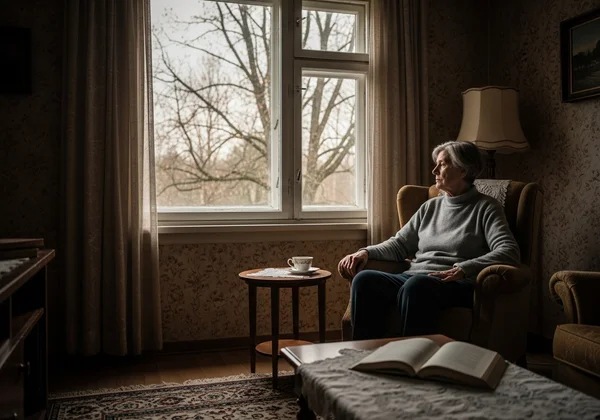Geriatric Depression Scale (GDS): Signs, Causes & Support for Older Adults
The golden years are often envisioned as a time of peace, reflection, and well-earned rest. Yet, for millions of older adults, this period is overshadowed by a silent and often misunderstood struggle: geriatric depression. This condition goes beyond fleeting sadness, profoundly impacting an individual's quality of life, physical health, and overall well-being. But how can you tell the difference between the natural process of aging and something more serious?
We understand the challenges, and this guide aims to offer clarity and support. We will explore the unique signs, common causes, and crucial pathways to help for depression in older adults. Understanding these elements is the first step toward fostering better mental health for yourself or the seniors you care for. An initial, gentle way to explore these feelings is through a simple screening, and you can take the first step on our homepage.
Understanding Geriatric Depression in Older Adults
Depression in later life isn't a normal part of aging. It's a treatable medical condition that affects seniors differently than younger adults. Recognizing these distinctions is key to providing effective support and encouraging a path toward recovery.

What Makes Geriatric Depression Unique?
Unlike depression in younger populations, which often presents with overwhelming sadness, geriatric depression can be more subtle. Seniors are less likely to report feeling "sad." Instead, their symptoms may manifest as persistent physical complaints, a general lack of energy, or a profound loss of interest in activities they once enjoyed. This can lead to misdiagnosis, with symptoms being mistakenly attributed to other medical conditions or simply the "slowing down" of age.
Is It Depression or Just Aging? Distinguishing Normal Changes
It's normal to experience emotional ups and downs with major life changes like retirement or the loss of loved ones. Grief is a natural response to loss. However, geriatric depression is different. It is characterized by a persistent and pervasive low mood or apathy that lasts for weeks or months, interfering with daily function. While aging might bring physical limitations, depression brings a heavy emotional weight that drains the joy from life.
Recognizing the Subtle Signs of Elderly Depression
Because seniors may not express their feelings directly, it's vital for family, caregivers, and healthcare providers to be observant. The signs can be emotional, physical, and even cognitive. Being aware of these indicators is crucial for early detection.
Emotional & Behavioral Indicators to Watch For
Keep an eye out for lasting changes in mood and behavior. An older adult struggling with depression might exhibit unexplained irritability, anxiety, or a persistent feeling of worthlessness. They may withdraw from social activities, neglect personal care, or express a fixation on death. Apathy, or a complete lack of interest in hobbies and relationships, is one of an incredibly common and powerful sign.
Physical Symptoms Often Overlooked
Often, the most prominent signs of geriatric depression are physical. Unexplained aches, chronic pain that doesn't respond to treatment, and persistent fatigue are common complaints. You might also notice significant changes in appetite leading to weight loss or gain, as well as sleep disturbances like insomnia or oversleeping. These physical symptoms can easily mask the underlying emotional distress.
Cognitive Changes: Memory, Focus & Decision-Making
Depression can significantly impact cognitive function, leading to what is sometimes called "pseudodementia." An older adult may experience difficulty concentrating, struggle with memory, and find it challenging to make simple decisions. While concerning, these cognitive issues often improve significantly once the underlying depression is treated. A clear mind is essential for well-being, and a free GDS screening can be a helpful starting point.

Key Causes & Risk Factors Impacting Senior Mental Health
No single cause leads to depression in older adults. Instead, it is typically a combination of biological, social, and psychological factors that create a perfect storm for emotional distress. Understanding these risk factors can help in both prevention and intervention.
Biological & Health Factors
Chronic illness is a major contributor to geriatric depression. Managing conditions like heart disease, diabetes, arthritis, or cancer can be physically and emotionally draining. Chronic pain, in particular, has a strong link to depression. Furthermore, certain medications can have side effects that affect mood, and neurological changes in the aging brain can also increase vulnerability.
Social Isolation & Major Life Transitions
Later life is often marked by significant transitions that can trigger depressive episodes. The loss of a spouse or close friends, retirement from a meaningful career, or a move from a cherished family home can lead to profound feelings of loneliness and purposelessness. This social isolation is a powerful risk factor, as meaningful connection is a cornerstone of mental wellness.

Psychological Vulnerabilities & Coping Mechanisms
A person's life history and psychological makeup also play a role. A history of depression earlier in life increases the risk of recurrence. Furthermore, some individuals may have developed coping mechanisms that are less effective in handling the unique challenges of aging. Feeling like a burden or struggling with a loss of independence can deeply impact self-esteem and mood.
Pathways to Support: Early Detection & Action
The good news is that geriatric depression is highly treatable. The journey begins with recognition and a courageous first step toward seeking help. With the right support system and tools, older adults can reclaim their emotional vitality.
When to Seek Professional Help
If you or a senior you know are experiencing persistent symptoms of depression, it is essential to consult a healthcare professional. A thorough evaluation can rule out other medical causes for the symptoms and lead to an accurate diagnosis. Remember, seeking help is a sign of strength, not weakness. A doctor can discuss various treatment options, including therapy, medication, and lifestyle adjustments.
The Role of the Geriatric Depression Scale (GDS) in Screening
Before a formal diagnosis, a simple screening can provide valuable insights. The Geriatric Depression Scale (GDS) is a scientifically validated, easy-to-use tool designed specifically for older adults. It consists of straightforward "yes" or "no" questions about mood and feelings over the past week. It's a non-invasive way to get a preliminary understanding of emotional health and can be a powerful conversation starter with a doctor. You can easily use the screening tool on our secure platform.

Practical Steps for Caregivers to Support Loved Ones
As a caregiver, your support is invaluable. Encourage open and honest communication without judgment. Help your loved one stay engaged by planning simple, enjoyable activities. Ensure they are eating nutritious meals and getting gentle exercise. Most importantly, assist them in seeking professional help and offer to accompany them to appointments. Your compassionate presence can make all the difference.
Empowering Seniors and Caregivers: Taking the First Step Towards Brighter Days
Recognizing and addressing geriatric depression can significantly improve the quality of life for older adults. With a clear understanding of its signs, causes, and available support, we can all contribute to their well-being and help them embrace their later years with joy and dignity. Taking that crucial first step — perhaps with a confidential GDS screening — can open the door to conversation and better mental health. We encourage you to explore our GDS tool today to gain valuable insights and start a positive dialogue about mental wellness. Remember, you're not alone in this journey, and support is always available.
Frequently Asked Questions About Geriatric Depression & Screening
What is the Geriatric Depression Scale (GDS)?
The Geriatric Depression Scale (GDS) is a widely used and respected screening tool designed to assess the mood of older adults. It helps identify potential signs of depression through a series of simple questions about their feelings. It is available in both a 30-item long form and a 15-item short form for quicker assessment.
Is the Geriatric Depression Scale (GDS) a diagnostic tool?
No, it is very important to understand that the GDS is a screening tool, not a diagnostic tool. It provides a score that indicates the potential severity of depressive symptoms. A high score suggests that a follow-up with a qualified healthcare professional, such as a doctor or psychologist, is highly recommended for a formal diagnosis and treatment plan. You can assess emotional well-being as a preliminary step.
Who can use the Geriatric Depression Scale?
The GDS is designed for a wide range of users. Seniors can use it for self-assessment in the privacy of their own homes. Family members and caregivers can use it to help monitor a loved one's emotional state. Healthcare professionals also use it as a quick and reliable tool for clinical screening in settings like hospitals, clinics, and nursing homes.
What does a high score on the Geriatric Depression Scale mean?
A high score on the GDS suggests the presence of significant depressive symptoms and indicates a higher likelihood of depression. It should be seen as a strong signal to schedule an appointment with a doctor for a comprehensive evaluation. It is not a definitive diagnosis but a crucial piece of information that can guide further action toward getting the right support and care.